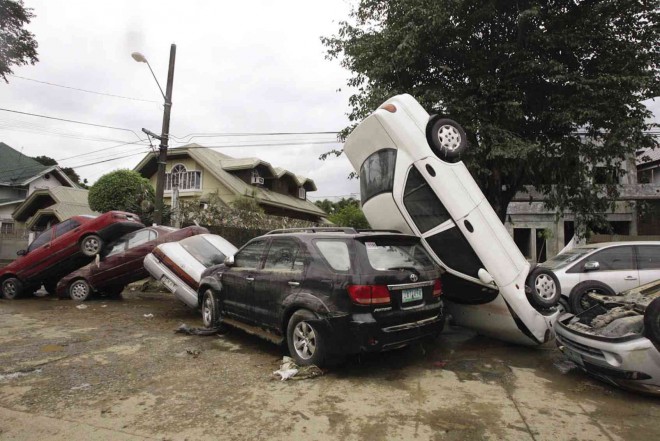Trauma lingers, apathy gone 6 yrs after ‘Ondoy’

SURVIVOR’S TALE Anita Santos points to the factory where she and her family moved for safety after the flash flood unleashed by “Ondoy ” reached the second floor of their home in Barangay Tumana, Marikina City.
IT HAS BEEN six years since Tropical Storm “Ondoy” (international name: Ketsana) unleashed devastating floods in the Metro, but the trauma remains fresh in the minds of the survivors, especially those in the hardest-hit areas.
“Sorry, I still get emotional when I remember that day,” Anita Santos said as she recalled the events of Sept. 26, 2009, when the onrushing spillage from nearby Marikina River submerged her two-story house at the corner of Bagong Farmers Avenue and Singkamas Street in Barangay Tumana, Marikina City. The whole structure went underwater within two hours.
The 68-year-old village watchman said she and her family of 10 had already “lost hope” that morning as they saw the water reaching their top floor. Fortunately, a neighbor called and helped them find safety: They clung to PVC pipes and walked perilously on top of a high wall to reach a factory nearby.
Sea instead of streets
They ended up joining around 200 other people on the factory’s third floor, staying there for the entire day without any food, potable water or extra clothing. Santos recalled peering through the factory’s window and seeing not the streets but a brownish sea littered with debris.
Article continues after this advertisementThat Saturday, Ondoy dumped on the capital and nearby provinces the equivalent of a month’s rainfall. The waterline of Marikina River rose to a staggering 23 meters above sea level.
Article continues after this advertisementOfficials later placed the damage in private property, agriculture and infrastructure at over P11 billion. Over 5 million people were counted among those affected. The death toll reached more than 400.
Despite the traumatic experience, Santos and most of her neighbors chose to rebuild and stay in Tumana, which is about 100 meters away from the river.
Leaving was the harder option, she said, since Tumana had been her home for more than half of her life. Aware of the risks of staying put, she decided to add another floor to her house—just in case another Ondoy comes rushing in.
Change in mindset
Apart from physical adjustments, she also tried to prepare her family mentally, especially the kids and grandchildren. “Go bags” or emergency packs containing a first-aid kit and handy food items, like biscuits, are now kept within their reach.
Such changes in mindset and behavior have since been evident among many Marikina residents.
Barangay Malanday resident Zenaida Cajayon admitted that before Ondoy, she hardly cared about the seminars on disaster response and preparedness being organized by the village or city government.
But all that apathy ended after she waded through waist-deep floodwaters just to get home that fateful day. The 51-year-old Cajayon recalled how 50 people took shelter in her house at the height of Ondoy’s fury.
City hall adapts
Today she is not only an active participant in the seminars but also a zealous promoter, encouraging her neighbors to attend.
And like Santos, Cajayon and her husband decided to renovate their three-story home and replaced its iron-sheet roofing with a concrete deck—their last refuge if trapped again by the flood.
Not just private citizens have learned to adapt.
Early this year, the city government inaugurated the local Legislative Building. In it
are the offices of the vice mayor and city councilors which are situated 27.5 meters above sea level or 4.5 meters higher than Ondoy’s watermark.
Also in the pipeline is the new P100-million city hall which will have similar height specifications. The current one is among the public buildings damaged by the 2009 deluge.
The local government has since been raising the specter of Ondoy in its campaign to save the Marikina Watershed, a protected area in neighboring Rizal province, whose thinning forest cover was also cited as a factor behind the massive flooding.
